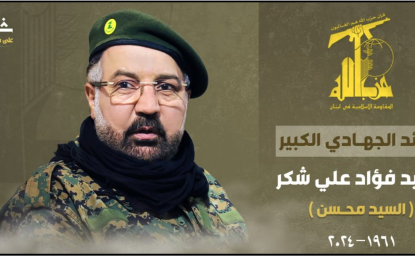US Intel: ISIS, al Qaeda, Hamas, & Hezbollah
The annual U.S. assessment covers global terrorist threats and the impact of the Gaza war.
The annual U.S. assessment covers global terrorist threats and the impact of the Gaza war.

On March 11, 2024, the annual US intelligence assessment reported that the regional affiliates of ISIS and al Qaeda are likely to expand in the future, despite leadership losses. The rival Islamist groups, which are both Sunni, are also likely to continue targeting US citizens and Western interests more broadly even as the Sunni global jihad shifts to Africa. “This threat is mostly likely to manifest in small cells or individuals inspired by foreign terrorist organizations and violent extremist ideologies to conduct attacks,” the Office of the Director of National Intelligence (ODNI) warned. The report also highlighted the capabilities of Hezbollah, a Lebanese Shiite group backed by Iran, to target Americans worldwide.
The war in Gaza between Israel and Hamas may “have a generational impact on terrorism,” Director of National Intelligence Avril Haines warned the Senate Intelligence Committee. Al Qaeda and ISIS have “directed supporters to conduct attacks against Israeli and U.S. interests.” The following are excerpts from the 2024 assessment.
U.S. persons and interests at home and abroad will face an ideologically diverse threat from terrorism. This threat is mostly likely to manifest in small cells or individuals inspired by foreign terrorist organizations and violent extremist ideologies to conduct attacks. While al-Qa‘ida has reached an operational nadir in Afghanistan and Pakistan and ISIS has suffered cascading leadership losses in Iraq and Syria, regional affiliates will continue to expand. These gains symbolize the shift of the center of gravity in the Sunni global jihad to Africa.
ISIS will remain a centralized global organization even as it has been forced to rely on regional branches in response to successive leadership losses during the past few years. External capabilities vary across ISIS’s global branches, but the group will remain focused on attempting to conduct and inspire global attacks against the West and Western interests.
Al-Qa‘ida’s regional affiliates on the African continent and Yemen will sustain the global network as the group maintains its strategic intent to target the United States and U.S. citizens. Al-Qa‘ida senior leadership has not yet announced the replacement for the former emir, Ayman al-Zawahiri, reflecting the regionally focused and decentralized nature of the organization.
Lebanese Hizballah will continue to develop its global terrorist capabilities as a complement to the group’s growing conventional military capabilities in the region. Since October 2023, Hizballah has conducted attacks along Israel’s northern border to tie down Israeli forces as they seek to eliminate HAMAS in Gaza. Hizballah probably will continue to conduct provocative actions such as rocket launches against Israel throughout the conflict.
The HAMAS attack against Israel in October 2023 and Israel’s responding military campaign in Gaza has increased tensions throughout the region as Iranian proxies and partners conduct anti-U.S. and anti-Israel attacks, both in support of HAMAS and to pressure the United States. Media coverage of the destruction and loss of life are being amplified by active social media campaigns on all sides, roiling public reactions among neighboring countries and around the world. Israel will face mounting international pressure because of the dire humanitarian situation in the Gaza Strip, and Iranian-backed attacks will jeopardize stability in Lebanon, Iraq, the Gulf, and the Red Sea. The risk of escalation into direct interstate conflict, intended or otherwise, remains high.
Israel and Iran are trying to calibrate their actions against each other to avoid escalation into a direct full-scale conflict. We assess that Iranian leaders did not orchestrate nor had foreknowledge of the HAMAS attack against Israel.
Since October 2023, Iran has encouraged and enabled its various proxies and partners—including Hizballah, Iranian-backed groups in Iraq and Syria, and the Huthis in Yemen—to conduct strikes against Israeli or U.S. interests in the region.
Both al-Qa‘ida and ISIS, inspired by the HAMAS attack against Israel, have directed their supporters to conduct attacks against Israeli and U.S. interests. The HAMAS attack is encouraging individuals to conduct acts of antisemitic and Islamophobic terror worldwide and is galvanizing individuals to leverage the Palestinian plight for recruitment and inspiration to conduct attacks. The Nordic Resistance Movement—a transnational neo-Nazi organization—publicly praised the attack, illustrating the conflict’s appeal to a range of threat actors.
In regard to Gaza, Jerusalem remains focused on destroying HAMAS, which its population broadly supports. Moreover, Israel probably will face lingering armed resistance from HAMAS for years to come, and the military will struggle to neutralize HAMAS’s underground infrastructure, which allows insurgents to hide, regain strength, and surprise Israeli forces.
The governance and security structures in Gaza and the West Bank as well as the resolution of the humanitarian situation in Gaza and rebuilding will be key components of the long-term Israeli–Palestinian relationship.
HAMAS’s and the PA’s continued animosity will be a factor in governance outcomes as will HAMAS’s broad popular support. Much also will hinge on Israel’s decisions regarding how to deal with Gaza in the aftermath of its campaign as well as scale and scope of its support for the PA.

Learn more about Hamas and how it relates to similarly aligned organizations throughout the region. Read more



